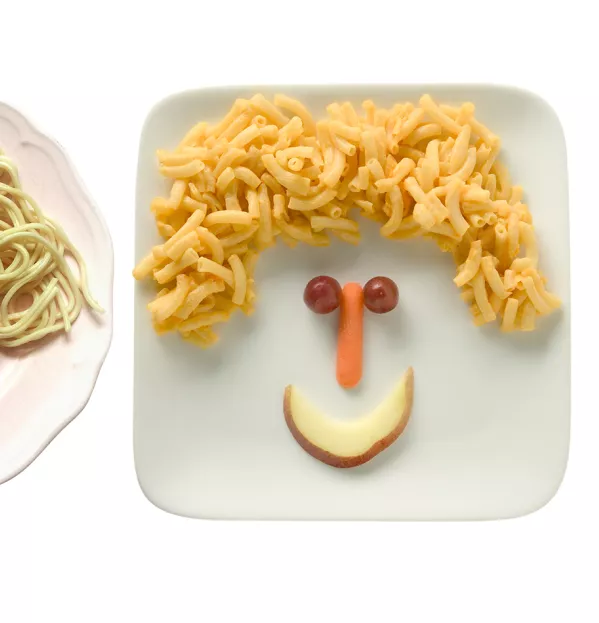School meals are transformed - but the cuts are hard to swallow

When East Renfrewshire’s catering coordinator, Nicky Joiner, started working in school kitchens 25 years ago, a big part of the job in secondary schools was frying chips.
In schools in Scotland, however, those times are long gone. The first shake-up of school food came as a result of the 2002 Hungry for Success report, a couple of years before celebrity chef Jamie Oliver launched his crusade to ban the Turkey Twizzler from English school canteens.
Hungry for Success led to new nutritional guidelines being introduced for school meals, with confectionery and sugar-heavy fizzy drinks being banned, fuelling misty-eyed headlines about the demise of the traditional school tuck shop.
Since then, the rules have become tighter still: the latest nutritional requirements came into force in April 2021, including reductions in processed and red meat. In East Renfrewshire, the move triggered what Joiner calls “Hamgate” - complaints from pupils unhappy about no longer being allowed their daily ham sandwich.
However, what is being eaten is just one of many changes to school meals in Scotland over the past decade. A huge expansion of who can eat them for free - combined with cultural and contextual impacts, the pandemic and the current cost pressures - has raised questions about how viable school meals are and what purpose they should serve.
- Free school meals: FSM “should go to all pupils urgently”
- Funding: Caterers warn school meals will get worse as costs soar
- Michael Gove: Extend free school meals to all universal credit recipients
All children in the first five years of primary in Scotland are now entitled to free meals. Initially, free meals were offered to P1-3 from January 2015, before the scheme was expanded. Some 186,965 primary children ate a free meal in February 2022, around 31,707 more than in February 2020 (up by 20.4 per cent).
The rollout of universal free school meals in primary is a policy that headteachers back - with some caveats. They say free meals ensure that children from “just-managing” families, who wouldn’t have qualified for free meals under the previous rules, don’t slip through the net - and that it is also helping schools to realise the health and wellbeing curriculum because children learn about healthy eating.

Extending free school meals
However, the expansion, which is costing almost £170 million a year and which the Scottish government says is saving families £400 per year per child, has not been without its challenges. Free meals were initially to be made available to all primary pupils by August 2022 but the rollout to the final two years of primary (P6-7) was delayed, with the government now only committing to realising the policy by the end of this Parliament in 2026.
Part of the problem is capacity: councils have asked for more time to rejig facilities to cope with another increase in numbers, but existing facilities are already stretched with the number currently accessing free school meals.
According to local authorities’ body Cosla, around 1,400 capital projects need to be taken forward for the universal free primary school meals policy to be fully realised; Joiner says in one school there isn’t even enough space to store the growing number of dinner plates. Funding allocated by government for these projects (approximately £30 million this year) is nowhere near enough to cover the cost.
Another issue is inflation: Joiner, who chairs the catering arm of council facilities management organisation Assist FM, says the cost of milk alone rose by more than 20 per cent in August. The £3.33 per meal the Scottish government pays is “not enough” and “does not touch the sides” of the true cost.
In her authority, she says, meals cost approximately £3.80 to produce, but in more rural authorities it is more than £4.
“The Scottish government funding was set a long time ago and there have been significant changes since then,” says Joiner. “Assist is continually saying there is a shortfall, a gap - and at the moment local authorities are having to fill that gap.”
And uptake of free meals in P1-5 is disappointingly low. While the overall number of primary children taking a free school meal has increased, the proportion of P1-5s actually taking up a free midday meal was just 68.4 per cent in February this year. In 2016, when only P1-3s got free school meals, more than 80 per cent took them.
‘So many costs have gone up… We need to deal with the fallout and make sure there are sufficient funds’
These figures may seem baffling as, with the current cost pressures for families, free school meals should be a lifeline. To try to root out what is happening, it is useful to look at East Renfrewshire because it bucks the trend, with 88.9 per cent uptake for free meals in P1-5, according to figures published in September. How does it do it?
Joiner says East Renfrewshire tries to maximise uptake by offering as much choice as possible. It also offers a restaurant-style service to its P1-3 pupils: they are served their meal instead of having to queue, and Joiner says she encourages catering staff to come out from behind serving counters and see the dining experience from the perspective of the child.
According to Joiner, key questions that can affect the uptake of free meals in a school are: is the canteen set-up logical? Can pupils read the signs? And (Joiner’s pet hate) is any child being asked to eat next to a bin?
This all fits with research about what can help to increase uptake of school meals.
A survey of almost 16,000 Scottish parents, published this year by online meals booking platform ParentPay with Assist FM, revealed that the top four factors that would encourage higher school meal uptake were: more choice; improving quality or making meals more appetising; lowering costs; and making it easier to select meals in advance.
Another piece of research this year by Glasgow Caledonian University found that while quality of food was important, so were other factors, including: the dining environment; the length of queues; the length of lunch breaks; and the information available about what is on offer.

Maximising uptake
This all comes at a cost, though, and new money for schools is not forthcoming. In Scotland, Joiner says, while the price of school meals can, of course, rise, this is usually set annually across a local authority area, and councils - not individual schools - subsidise costs, creating more stability.
Yet there is variation in what councils charge. The price of a two-course lunch in North Lanarkshire is £3.10 for primary schools and £3.15 for secondaries. In East Renfrewshire Council, however, it is £2.20 for a primary lunch and £2.40 for a secondary lunch - at least for now.
Just last week, the authority launched a consultation over a range of cuts. One proposal is to increase the price of school meals by 20p to generate £100,000 and to reduce support staff, including catering staff. The authority acknowledges this would lead to “a reduction in the range of school meals”.
Joiner is managing to balance her budget for now, but she says school caterers are feeling the pressure.
“Since the government settled on that £3.33 per meal figure, so many costs have gone up - the hourly rate for staff has risen significantly, the cost of food has gone up significantly and the cost of transport has gone up significantly,” she says.
“There are so many factors that were not considered because the government didn’t know they were going to happen [but] we need to deal with the fallout and make sure there are sufficient funds.”
The Scottish government says the planning process it is undertaking with councils for rolling out free meals to the final two years of primary “will also consider the costs of providing meals”.
‘We are facing a challenge if we want to achieve the government’s goal of halving childhood obesity’
Joiner says it is beneficial for school catering to come under the remit of a local authority’s director of education. The director may take a personal interest and even taste dishes and get feedback from pupils. It was in one such meeting in East Renfrewshire that disgruntled students raised their complaints about the disappearance of ham sandwiches. However, Joiner also points out that East Renfrewshire is “tiny” and has some big advantages, such as being able to transport meals to schools more easily.
“In a lot of authorities, that can’t happen because of geography - in the Scottish Borders, it can take you one and a half hours to travel between different schools.”
Choice of food is a particularly interesting part of the challenge when it comes to school meals. What is healthy is not always what children want to eat. Some argue that the push for healthy eating may be putting some children off opting for school meals.
Lorraine Tulloch, programme lead for Obesity Action Scotland, acknowledges that there is a balance to be struck between what will “sell” and what is nutritious. However, she believes the key is not offering more pizzas but changing eating habits.
Obesity Action Scotland has long campaigned for the “school feeding culture” to be transformed into an “eating culture”. It wants a positive physical and social environment for school meals, as well as for the government to go further and introduce stricter school food guidelines.
Obesity Action Scotland wants free-sugar content to be reduced so it meets the new Scottish dietary goals, and also for schools to serve less “ultra-processed food” - so instead of schools offering healthier versions of pizza, sausages or burgers, the campaign group wants school kitchens to help children change their eating habits.

Healthy but appetising
Tulloch says: “Last year, we saw quite a significant uptick in the rates of childhood obesity for children entering P1, likely because of the pandemic restrictions, so we know we are facing a challenge if we want to achieve the government’s goal of halving childhood obesity.”
It’s not just choice that is the problem, though, according to Joiner. She believes that low uptake of free meals is a hangover from Covid, after some authorities replaced hot meals with packed lunches eaten in classrooms in a bid to limit mixing. In some places, that was “a disaster” because children stopped taking school dinners altogether.
However, not all the changes brought about by Covid have had a negative impact.
The staggered lunches that some schools introduced to stop children mixing have been retained at Rockfield Primary in Oban, says headteacher Caroline Fothergill, making lunchtime a more relaxed affair.
The school shares a campus and dining room with St Columba’s Primary, and lunchtime - which typically involves around 500 pupils - runs from 12pm to 1pm for P1-4, and 12.45pm to 1.45pm for P5-7.
‘Staggered lunches mean there’s a lot less queuing and there’s more opportunity for children to relax’
This means fewer of the dreaded queues that often put children off school meals. Pupils are also less likely to have to rush their food to make way for the next wave of hungry diners.
“It means there’s a lot less queuing and there’s more opportunity for children to relax and enjoy their lunch,” says Fothergill. “They are not being rushed out. They can take their time. They can have that lovely social experience as well.”
Jonathan Cunningham, headteacher of Knightswood Primary in Glasgow, and vice-president of primary school leaders’ body the AHDS, has a similar system in place. At the school, which has a roll of just over 500 pupils, lunchtime has been staggered for a long time and Cunningham cites the same key advantages: it cuts down on queuing and he isn’t having to chase pupils out of the dining hall to free up seats.
But, despite these positive experiences, it’s clear that school meals - and the infrastructure around them - need more investment quickly, along with more guidance on what to offer to ensure children take up the free meals.
Finding the right solutions to all the above problems is key, as school meals should remain a fundamental part of the school day beyond ensuring that children are fed. Headteachers say they are crucial for educating pupils about food and encouraging children to be more adventurous in their tastes and to eat healthily.
Unfortunately, the signs are that budget cuts are going to reduce the quality and choice available in school canteens - and, after so much progress, that is bad news for pupils in Scotland.
Emma Seith is a senior reporter at Tes Scotland. She tweets @Emma_Seith
You need a Tes subscription to read this article
Subscribe now to read this article and get other subscriber-only content:
- Unlimited access to all Tes magazine content
- Exclusive subscriber-only stories
- Award-winning email newsletters
Already a subscriber? Log in
You need a subscription to read this article
Subscribe now to read this article and get other subscriber-only content, including:
- Unlimited access to all Tes magazine content
- Exclusive subscriber-only stories
- Award-winning email newsletters
topics in this article



